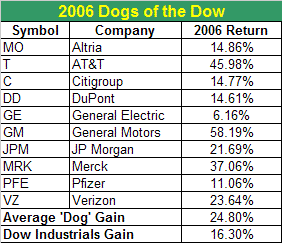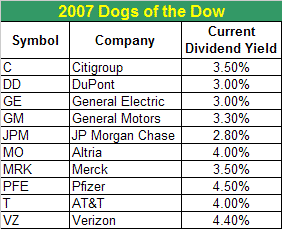With the new year upon us, it's time to dust off the Dogs of the Dow theory again. For those of you not familiar with the premise, it's pretty simple. Of the thirty stocks that make up the Dow Jones Industrial Average, the "dogs" are the ten stocks in the Dow that are considered to be the most undervalued. The theory is that those ten most undervalued stocks (the "dogs") at the end of one year are poised to beat the Dow Average the following year. Does it work? Surprisingly, it does work more often than not. Let's take a look.
How do we determine "undervalued" for the purposes of this theory? In this particular case, we look at the dividend yield. While it's not necessarily the perfect measure of value for a stock, it is generally a good indication of how one stock compares to another. This is especially true for old blue-chip stocks like the ones you find in the Dow, where dividends are a little more common. To find your undervalued dogs, simply find the ten Dow stocks with the highest dividend yields.
But does this really work? There are always exceptions, but the idea does have some statistical merit, but only a little, recently. Since the mid-90's, the theory only helped about half the time. In other words, the ten highest yielding stocks outperformed the overall Dow average over the last decade or so about half the time.
This didn't mean that the ten dogs didn't lose money in some years, such as 2001 and 2002. But even in those years, you still would have been better off with the dogs. The idea didn't work in 2005, yet did very well in 2006. Over a longer time frame though, the numbers statistically support the theory. From the early 70's, the average annual return on this theory would have been 17.1%. That's significantly better than the Dow's average annual gain of 10.9%.
The bottom line? Since the theory has superior results, we're interested in it. And regardless of the comparative results, we still like the idea of relatively low priced stocks. We just don't want to follow it blindly, in case we get another laggard like General Electric (GE) was last year - not that we're complaining. Pfizer (PFE) was the only other significant laggard in 2006, but is still gained 11%.
Take a look at last year's dogs and how they fared against the Dow.
Dogs of the Dow - 2006

So what about 2007? Take a look below for this year's "dog" candidates. It's neither logical nor scientific, but it is food for thought. If the theory holds up, these stocks will have outperformed the Dow Average when we check in again at the end of this year.
Dogs of the Dow - 2007

Price Headley is the founder and chief analyst of BigTrends.com.